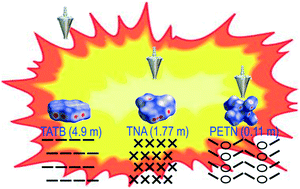当前位置:
X-MOL 学术
›
CrystEngComm
›
论文详情
Our official English website, www.x-mol.net, welcomes your feedback! (Note: you will need to create a separate account there.)
Relationship between the crystal packing and impact sensitivity of energetic materials
CrystEngComm ( IF 3.1 ) Pub Date : 2018-01-12 00:00:00 , DOI: 10.1039/c7ce01914a Beibei Tian 1, 2, 3, 4, 5 , Ying Xiong 4, 5, 6, 7 , Lizhen Chen 1, 2, 3, 4 , Chaoyang Zhang 4, 5, 6, 7, 8
CrystEngComm ( IF 3.1 ) Pub Date : 2018-01-12 00:00:00 , DOI: 10.1039/c7ce01914a Beibei Tian 1, 2, 3, 4, 5 , Ying Xiong 4, 5, 6, 7 , Lizhen Chen 1, 2, 3, 4 , Chaoyang Zhang 4, 5, 6, 7, 8
Affiliation

|
The crystal packing structure–safety (usually represented by sensitivity) relationships of energetic materials (EMs) are requisite to set a basis for tailoring new ones with the desired safety by means of crystal engineering, because safety is one of the two most important properties of EMs for which there is always a high concern. Nevertheless, there is still no such relationship. This work proposes a straightforward and qualitative relationship between the packing structures and impact sensitivity of EMs, covering conventional EMs, energetic co-crystals, energetic solvates, and energetic ionic salts. Meanwhile, we propose a straightforward method to quickly identify the packing mode by the shape of the Hirshfeld surface and the distribution of the red dots on the surface of the molecule involved in an energetic crystal. As a result, we find that an EM with a packing structure of ready shear sliding tends to possess a low impact sensitivity, in combination with a high molecular stability. That is, a perfect face-to-face π-stacking, constructed by big π-bonded molecules together with strong intra- and intermolecular hydrogen bonding, is preferred to impact insensitive EMs; moreover, if the intermolecular interactions and their anisotropy in an energetic crystal are enhanced, its impact sensitivity is expected to be improved too. Hopefully, the proposed relationship will facilitate understanding of the sensitivity mechanism of existing EMs, and will contribute to set a basis for guiding new EM constructions by molecular and crystal designs.
中文翻译:

晶体堆积与高能材料冲击敏感性之间的关系
高能材料(EM)的晶体堆积结构与安全性(通常用灵敏度表示)的关系是通过晶体工程学为定制具有所需安全性的新材料奠定基础的必要条件,因为安全性是高能材料的两个最重要特性之一。始终受到高度关注的新兴市场。但是,仍然没有这种关系。这项工作提出了EM的堆积结构和冲击敏感性之间的直接和定性的关系,涵盖了常规EM,高能共晶体,高能溶剂化物和高能离子盐。同时,我们提出了一种简单的方法,可以通过Hirshfeld表面的形状和高能晶体所涉及的分子表面上的红点的分布来快速识别堆积模式。因此,我们发现具有快速剪切滑动堆积结构的EM往往具有较低的冲击敏感性,并具有较高的分子稳定性。也就是说,对不敏感的EM来说,由大的π键结合的分子以及强大的分子内和分子间氢键构成的理想的面对面π堆叠更可取。此外,如果增强高能晶体中的分子间相互作用及其各向异性,则其冲击灵敏度也有望得到改善。希望所提出的关系将有助于理解现有EM的敏感性机制,并将为通过分子和晶体设计指导新的EM结构奠定基础。与高分子稳定性相结合。也就是说,对不敏感的EM来说,由大的π键结合的分子以及强大的分子内和分子间氢键构成的理想的面对面π堆叠更可取。此外,如果增强高能晶体中的分子间相互作用及其各向异性,则其冲击灵敏度也有望得到改善。希望所提出的关系将有助于理解现有EM的敏感性机制,并将为通过分子和晶体设计指导新的EM结构奠定基础。与高分子稳定性相结合。也就是说,对不敏感的EM来说,由大的π键结合的分子以及强大的分子内和分子间氢键构成的理想的面对面π堆叠更可取。此外,如果增强高能晶体中的分子间相互作用及其各向异性,则其冲击灵敏度也有望得到改善。希望所提出的关系将有助于理解现有EM的敏感性机制,并将为通过分子和晶体设计指导新的EM结构奠定基础。如果增强高能晶体中的分子间相互作用及其各向异性,则其冲击灵敏度也有望得到改善。希望所提出的关系将有助于理解现有EM的敏感性机制,并将为通过分子和晶体设计指导新的EM结构奠定基础。如果增强高能晶体中的分子间相互作用及其各向异性,则其冲击灵敏度也有望得到改善。希望这种提议的关系将有助于理解现有EM的敏感性机制,并将为通过分子和晶体设计指导新的EM结构奠定基础。
更新日期:2018-01-12
中文翻译:

晶体堆积与高能材料冲击敏感性之间的关系
高能材料(EM)的晶体堆积结构与安全性(通常用灵敏度表示)的关系是通过晶体工程学为定制具有所需安全性的新材料奠定基础的必要条件,因为安全性是高能材料的两个最重要特性之一。始终受到高度关注的新兴市场。但是,仍然没有这种关系。这项工作提出了EM的堆积结构和冲击敏感性之间的直接和定性的关系,涵盖了常规EM,高能共晶体,高能溶剂化物和高能离子盐。同时,我们提出了一种简单的方法,可以通过Hirshfeld表面的形状和高能晶体所涉及的分子表面上的红点的分布来快速识别堆积模式。因此,我们发现具有快速剪切滑动堆积结构的EM往往具有较低的冲击敏感性,并具有较高的分子稳定性。也就是说,对不敏感的EM来说,由大的π键结合的分子以及强大的分子内和分子间氢键构成的理想的面对面π堆叠更可取。此外,如果增强高能晶体中的分子间相互作用及其各向异性,则其冲击灵敏度也有望得到改善。希望所提出的关系将有助于理解现有EM的敏感性机制,并将为通过分子和晶体设计指导新的EM结构奠定基础。与高分子稳定性相结合。也就是说,对不敏感的EM来说,由大的π键结合的分子以及强大的分子内和分子间氢键构成的理想的面对面π堆叠更可取。此外,如果增强高能晶体中的分子间相互作用及其各向异性,则其冲击灵敏度也有望得到改善。希望所提出的关系将有助于理解现有EM的敏感性机制,并将为通过分子和晶体设计指导新的EM结构奠定基础。与高分子稳定性相结合。也就是说,对不敏感的EM来说,由大的π键结合的分子以及强大的分子内和分子间氢键构成的理想的面对面π堆叠更可取。此外,如果增强高能晶体中的分子间相互作用及其各向异性,则其冲击灵敏度也有望得到改善。希望所提出的关系将有助于理解现有EM的敏感性机制,并将为通过分子和晶体设计指导新的EM结构奠定基础。如果增强高能晶体中的分子间相互作用及其各向异性,则其冲击灵敏度也有望得到改善。希望所提出的关系将有助于理解现有EM的敏感性机制,并将为通过分子和晶体设计指导新的EM结构奠定基础。如果增强高能晶体中的分子间相互作用及其各向异性,则其冲击灵敏度也有望得到改善。希望这种提议的关系将有助于理解现有EM的敏感性机制,并将为通过分子和晶体设计指导新的EM结构奠定基础。



























 京公网安备 11010802027423号
京公网安备 11010802027423号